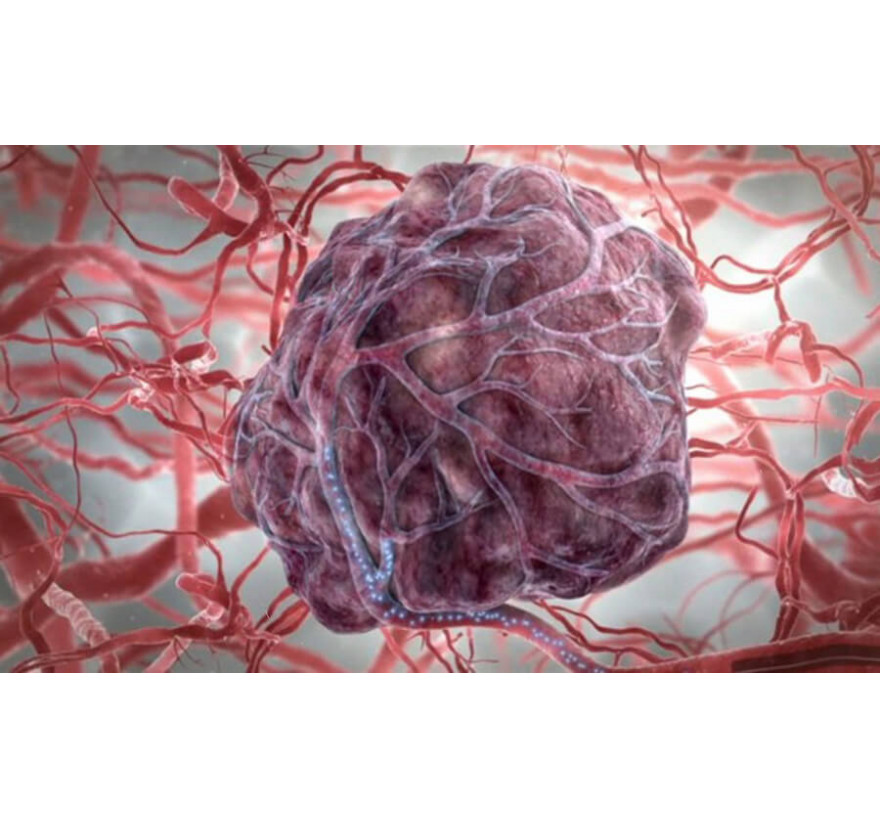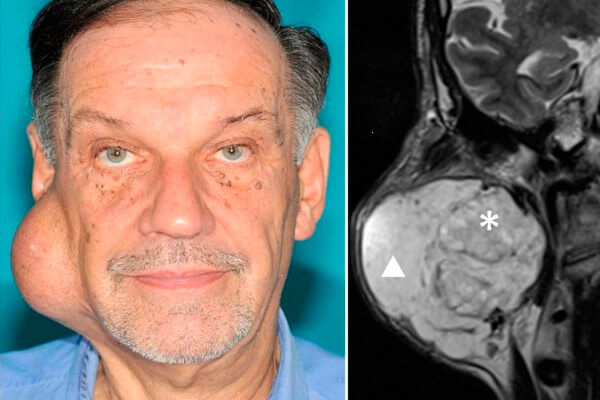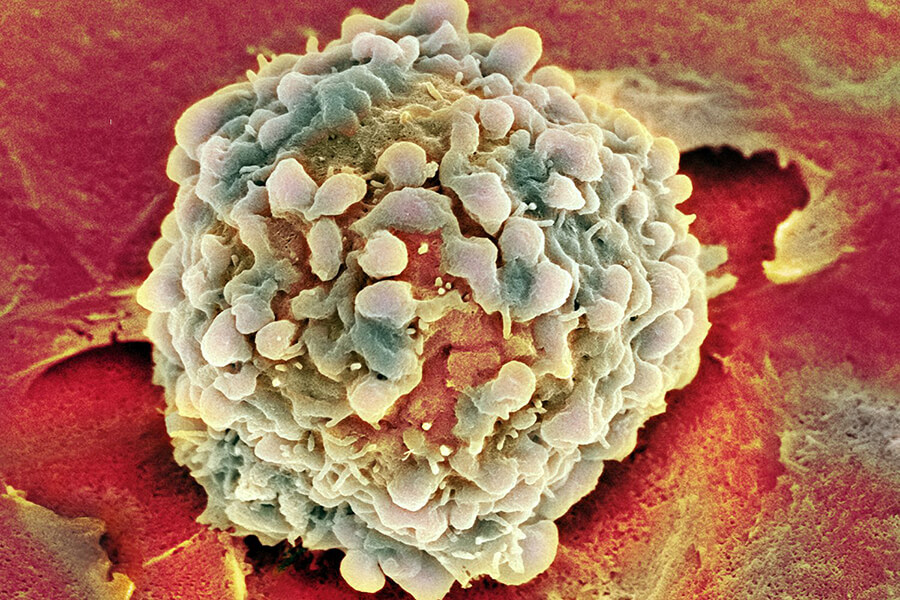Malignant tumor - what is it and the causes of the appearance

The cells of such a neoplasm can move through the bloodstream and infect other organs. Such a tumor simultaneously affects several vital systems of a person, gradually destroying it.
Malignant tumor and how it develops
Malignant cells differ from normal ones - changes in structure and functions occur, differentiation and reproduction processes change. Transformations also take place in the form and size of cells, in the balance of epithelial cells and parenchyma - tissue atypism occurs. All this is typical for immature malignant neoplasms.
In addition to existing cellular atypism, which is a sign of impaired cell differentiation and a sign of tumor growth, there is also an atypism of ultrastructures, the manifestation of which is an increase in ribosomal structures. Cell biochemistry also undergoes transformation - with a tumor, the number of anaerobic processes increases, and the number of aerobic enzyme systems decreases. This leads to the accumulation of lactic acid, which is characteristic of a malignant tumor.
Like cancer, a malignant neoplasm can grow into adjacent tissues and organs, give metastases, destroying the body, some types of cancer develop rapidly, others can not manifest themselves for many years.
The neoplasm itself can occur in any organ or tissue and is a cell that differentiated and acquired new properties and lost their former. Around the cancer cells a kind of capsule forms, which, as the tumor cells grow, moves apart, occupying an increasingly large volume. The appearance of neoplasms can occur under the influence of various factors or processes within the body.
It should be noted that a malignant tumor is not always cancer, and that this does not always happen - the transformation of the neoplasm into cancer, but in the vast majority of cases, malignancy of cells still occurs. For example, in a precancerous condition, when some changes in an organ or tissue have occurred, triggers are needed for the appearance of the cancer itself. Therefore, it is important to identify these conditions in order to avoid their further development in cancer and the terrible consequences of this disease.
Incidence
Every year, more than 10 million cases of cancer of various origin and types are diagnosed in the world. According to statistics, cancer mortality takes 2nd place after diseases of the cardiovascular system. Among oncological diseases themselves, lung cancer predominates, followed by breast cancer. The worst predictions have: lung, stomach, and breast cancer - they are the most dangerous and in the last stages are incurable. A more favorable prognosis for cancer in situ. Disappointing is the fact that every year the number of people on Earth who suffer from cancer is increasing.
There are cancer diseases that are more common among representatives of any race, while others do not make racial differences. But more often, cancers are diagnosed in older people.
Types of cancer
Malignant (in other words, incurable) formations seriously threaten a person, endangering not only health, but also his life. Such formations grow at a tremendous speed, affect nearby tissues and organs, give metastases, recur and simply kill a person.
According to the type of tissue the tumor formed, the following forms of malignant neoplasms are obtained:
Organ-specific epithelial (exo- and endocrine glands, integument);
Organ-specific epithelial (in places of atypical location of epithelial tissue);
Melanogenous tissue;
Mesenchymal;
Nervous system and membranes of the brain (spinal cord);
Formed from germinal tissue;
Hematopoietic and lymphatic tissues (hemoblastoses).
Depending on the type of source cells, neoplasms can be divided into:
Carcinomas (cancer) - formed from epithelial cells;
Sarcomas - from cells of connective tissue;
Melanomas - from melanocytes;
Leukemia - from blood-forming bone marrow cells;
Teratomas - from gonocytes;
Lymphomas - are formed from lymph cells;
Gliomas - formed from neuroglia cells;
Choriocarcinomas - from trophoblast cells.
Types of cancer (carcinoma) are divided depending on the variety of epithelium from which it is formed, and structural features:
Squamous with keratinization and without keratinization;
Adenocarcinoma;
Trabecular cancer (solid formation);
Cancer in situ (in situ);
Fibrous;
Slimy;
Medullary;
Small cell.
According to morphology, cancer can be:
Differentiated (slowly growing and slowly giving metastases) cancer, it is divided into highly differentiated (low malignancy), moderately differentiated and slightly differentiated;
Undifferentiated (rapidly developing, refers to fast-growing species and gives metastases), it refers to more aggressive types of cancer and pose a real threat.
By the number of foci of pathology, oncological neoplasms can be:
Multicentric (simultaneously several primary foci);
Unicentric (one primary focus).
Also, malignant multicellular neoplasms can be divided depending on the characteristics of growth in the lumens of organs into:
Expansive (exophytic growth), in this case, the tumor develops into the lumen of the organ;
Infiltrating (endophytic growth), cancer develops into the wall of an organ or surrounding body tissues.

Degrees of disease
Classification according to the TNM system, where T - tumor, N - nodulus (nodes), M - metastasis (metastases) classifies malignant tumors in accordance with the degree of prevalence of the tumor process, involvement in the process of lymph nodes and whether or not there are metastases.
The stage of development of cancer is indicated by the Tis (T0) index - cancer in situ or T1-T4. In the first case, it means that the transformed cells are located inside the tissue (intraepithelially) without sprouting into others nearby. In the second case, the numbers express the stages of tumor development from minimum to maximum.
The degree of involvement of regional lymph nodes in the tumor process is indicated by Nx values - when no lymph nodes were examined, N0 - no changes in lymph nodes, N1 - confirmed changes in regional lymph nodes.
The presence of metastases is also indicated by various adjacent values - Mx - no metastases were examined, M0 - distant metastases were not detected, M1 - distant metastasis was confirmed.
Causes and risk factors
The reasons for the transition of precancer to cancer are not exactly clarified, why this occurs is not always clear, but several stages of this process are determined:
Regeneration is disturbed;
There are changes that precede the onset of a tumor - dysplasia, hyperplasia;
Staged transformations occur in the expanding tissue;
The germ of a tumor is formed;
The development and growth of the tumor itself occurs.
According to the existing theory of the "tumor field" in the organ in a certain place there are growth points that make up the nucleus of the future tumor. But most researchers still agree that the cause of the occurrence of a low-grade tumor is genetic disorders in the cell. Naturally, this process does not occur on the same day, but develops over a period of time, and for progression, appropriate conditions and prerequisites are necessary.
The growth of tumors in the human body can lead, for example:
Smoking (including passive);
Viral infections;
The effect of chemicals;
Improper nutrition (predominance of fats in the diet);
Obesity (as a result of malnutrition);
A large amount of ultraviolet radiation.
In a word, various physical, chemical, and biological factors can be provocateurs of cancer.
There are many theories about why a malignant (incurable) formation appears, what leads to it, what is the nature of this disease, these theories are diverse and are called:
Physico-chemical (Virchow's theory), which explains the occurrence of cancerous tumors, as a result of the influence on the body of various endogenous and exogenous carcinogens, permanent trauma (stroke, tissue integrity);
Dysontogenetic (Congheim theory), explaining the appearance of cancer cells by their origin in the embryonic period;
Viral genetic theory (Zilber) considers the presence of oncogenic viruses in humans as the main impetus for the development of cancer, for example, type 4 herpes virus (Epstein-Barr), papillomavirus, hepatitis, immunodeficiency, T-cell leukemia;
Immunological theory (Burnet), suggests that the formation of tumor cells is provoked by a malfunction in the human immune system;
The polyetiological theory (Petrova) suggests that the formation of a tumor provokes a combination of many factors, resulting in a lack of natural anti-cancer protection.

Cancer Symptoms
A doctor must be consulted to make a diagnosis, but some symptoms that can be noticed should alert:
The appearance of a small speck (brighter in color), which increases with time;
The appearance of a wound or ulcer from which blood is secreted or touching which causes pain;
The appearance of seals under the skin, which can be determined by touch (hard or jelly-like or other consistency);
Enlarged lymph nodes.
In addition to these external manifestations, the symptoms of a cancerous tumor include:
Fever;
Change in skin color (turns pale or yellow);
Lack of appetite;
General weakness;
Wandering pains;
The emergence of physical sensations that were not there before.
Malignant neoplasms have both local and systemic effects on the body. Local consequences are the compression of any organs adjacent structures due to a growing tumor. Systemic exposure is characterized by general intoxication of the body by the decay products of the tumor (when a cancer capsule breaks), which eats healthy body cells.
Local signs of cancer are very diverse and depend on the location of the neoplasm, stage of its development, etc.
Of course, the appearance of these signs does not always indicate the presence of a malignant tumor, but early diagnosis should not be neglected. If it is nevertheless cancer, then its early detection will increase the chances of recovery, it can be cured, while later oncology diagnosis reduces the chances of a complete cure. Metastasis in the last stages gives little chance of cure, patients die most often from metastases.
Diagnosis
The use of a particular diagnostic method depends on the location of the neoplasm. But the general research program is as follows:
A personal examination is carried out by a specialist;
Ultrasound, MRI, CT, X-ray, endoscopy are prescribed;
General tests of urine and blood, a biochemical blood test, a blood test for tumor markers (to check the tumor for malignancy).
A biopsy is a method used to establish a final diagnosis using histology or cytology.
How to distinguish a benign tumor from a malignant
What is the difference between a benign tumor and a malignant one? They are usually divided into three groups, where the difference between them is visible by whether it is possible to find out from which cells the cancer cells were originally reborn or not:
Benign, these are the ones by which you can determine from which cells they grew, you can diagnose the speed of the tumor, and tumors are also characterized by the absence of metastases. These tumors are treatable. But even benign tumors are not all safe for humans and some of them can degenerate into malignant;
Malignant, these include cells that have lost their resemblance to the tissues from which they are reborn. Such tumors grow quite quickly, the oncology process is proceeding quite rapidly;
Tumors with locally destructive growth, this type of tumors include those when the determination of their benignness or malignancy is not possible, and they are classified as potentially malignant.
Treatment
Malignant tumors can be treated in several ways.
Surgical treatment is the main one in oncology, and it has long been used in almost all types of neoplasms. This method is not used for cancer inoperability - when surgery may endanger the patient’s life.
Radiation therapy is used as an independent and as an auxiliary method for the treatment of cancer. This method involves the use of ionizing radiation on cancer cells.
Chemotherapy acts on tumor cells with special drugs. This type of therapy is selected individually. But it may not be used in all cases, since not every neoplasm lends itself to such treatment. Chemotherapy is also used before and after surgery, so that the excised tumor does not give relapse (procedures) or metastasis (after surgery) or to reduce tumor growth or slow it down (before surgery).
Immunotherapy is the use of special substances (monoclonal antibodies, vaccines, cytokines, activated lymphocytes) in combination with surgical intervention. To date, this method of treatment is one of the most promising and effective in the treatment of this pathology.
Photodynamic therapy uses a substance containing a photosensitizer for treatment, which is injected into the affected organs, and then the substance is exposed to a laser or other light source, and this causes the death of cancer cells.
A method of treating malignant tumors depends on its location, stage of development, the presence of metastases, the type of tumor, and general condition.
If a cancer patient is in the terminal stage of the disease, then palliative treatment is prescribed that only alleviates the patient’s condition, which means that cure is no longer possible.
Disease prevention
Prevention of malignant tumors consists in observing the correct lifestyle, giving up bad habits (smoking, alcohol, overeating). These include tight control over all kinds of viral and infectious diseases, passing tests for the control of hepatitis B and C.
A prerequisite for secondary prevention of the disease is regular oncological examination and early oncoscreening.
Disease prognosis
The prognosis of the disease depends on many factors, primarily on the stage of the disease, the location of the tumor, the shape of the tumor, the general health of the patient who is ill with cancer, the age of the patient.
Five-year survival for patients with cancer is individual, depends on all of the above factors and ranges from 10 to 90%. An undifferentiated cancer has the most unfavorable prognosis, since it is more prone to metastasis and gives a higher percentage of deaths.
Questions on the topic
What is folate-dependent, estrogen-dependent tumors?
Folate-dependent tumors are neoplasms whose growth and development depend on the level of folic acid in the body. Estrogen-dependent (breast cancer, for example) forms of cancer are directly related to the level of estrogen in the blood. In both cases, in the treatment of tumors, the level of the influencing element is normalized with the help of drugs.
What types of cancer are rare?
There are several types of cancer that are classified as rare: gall bladder cancer, vulvar cancer, tracheal cancer.
What is an orostoma?
This is a malignant tumor in the oral cavity.
Is there a difference in the presence of blood flow in the tumor or not?
Since blood supply is necessary for the development of a tumor, its absence is better, i.e. nutrition will not come, and a tumor without blood flow will not develop that way.
The name of the disease is “cancer” of the male gender, but is there a name for this disease of the female gender?
You can call it "carcinoma" according to the original source of the name, which in translation means "cancer".
